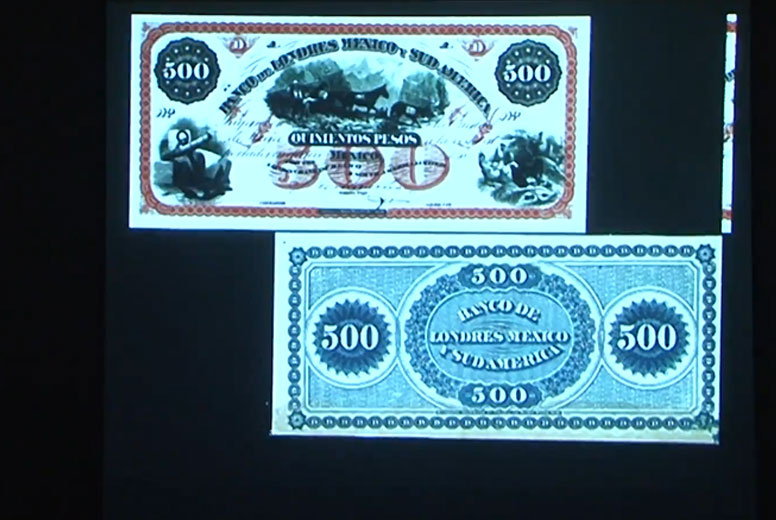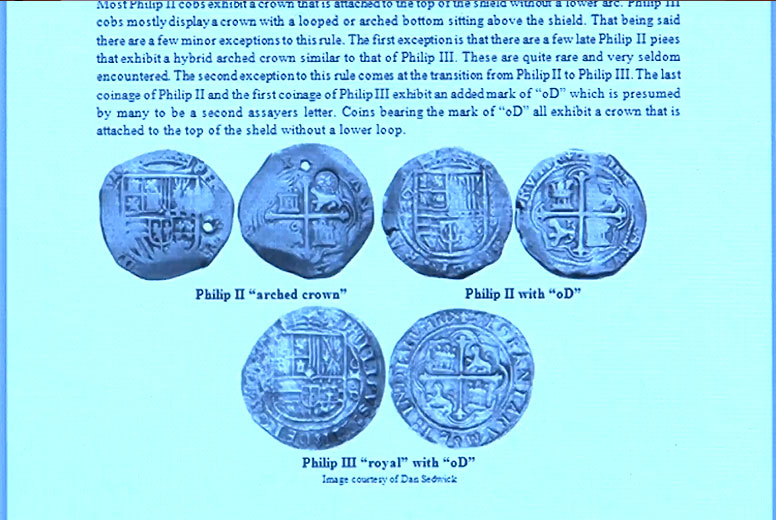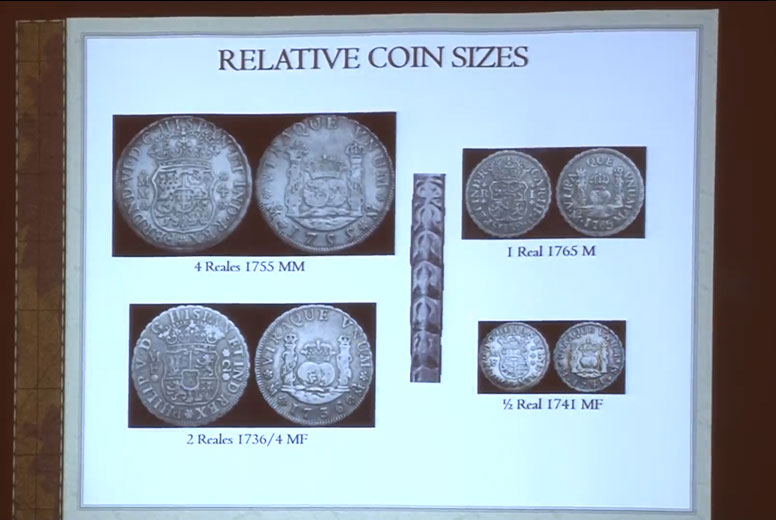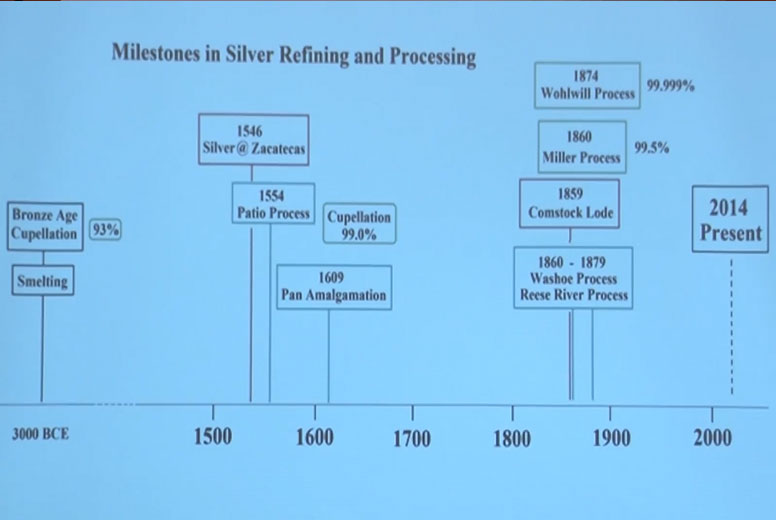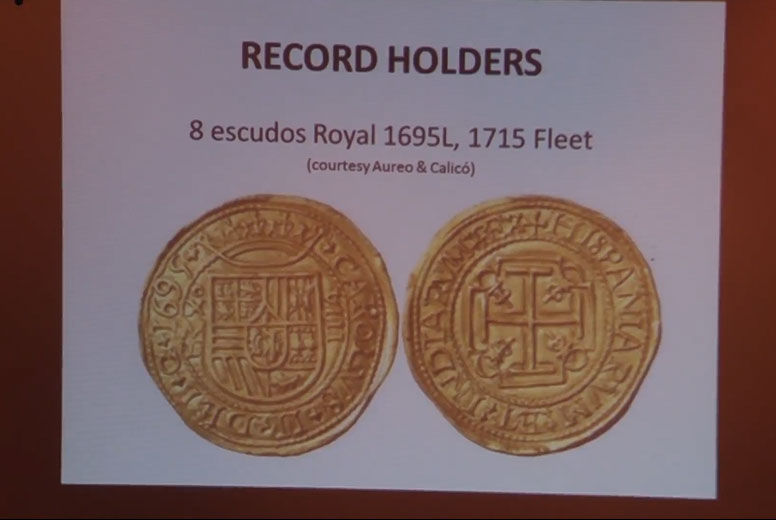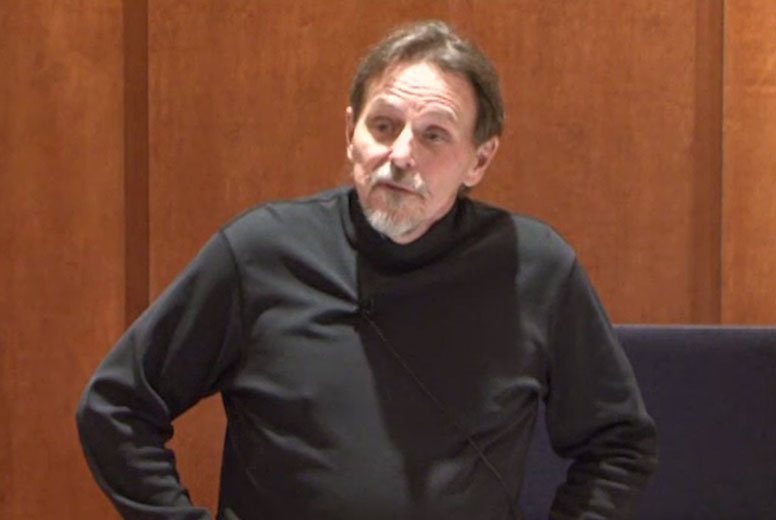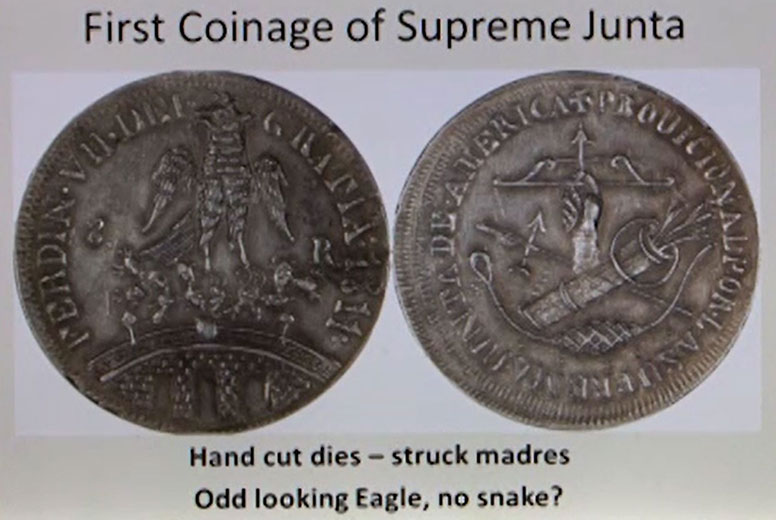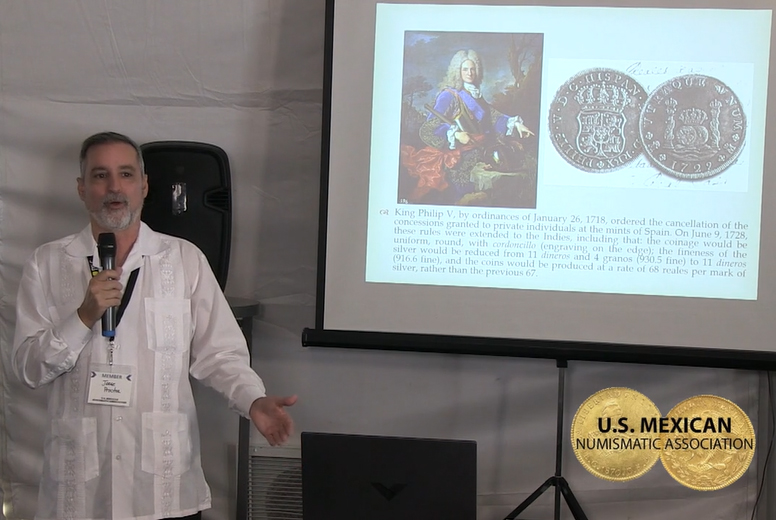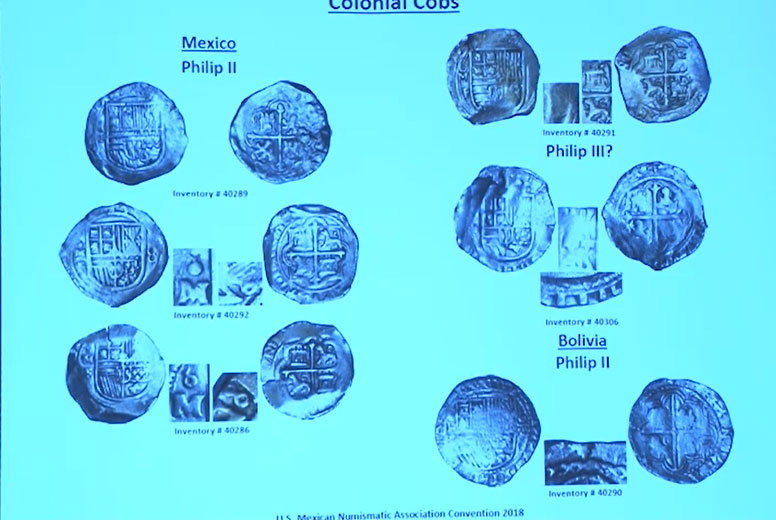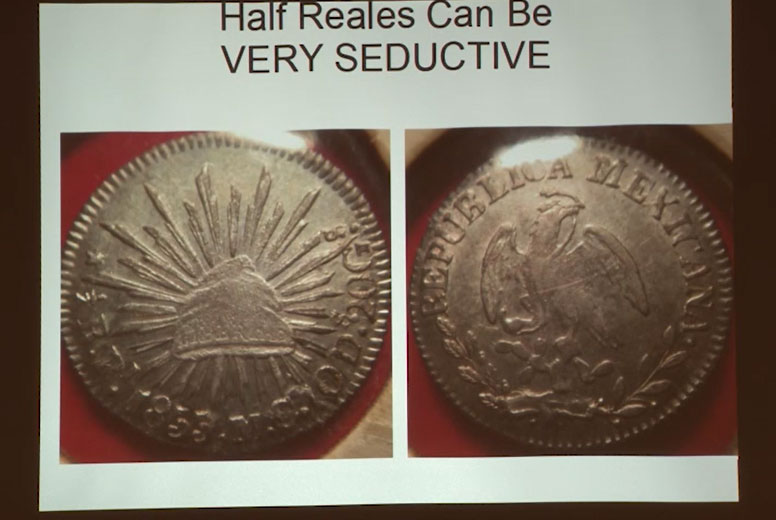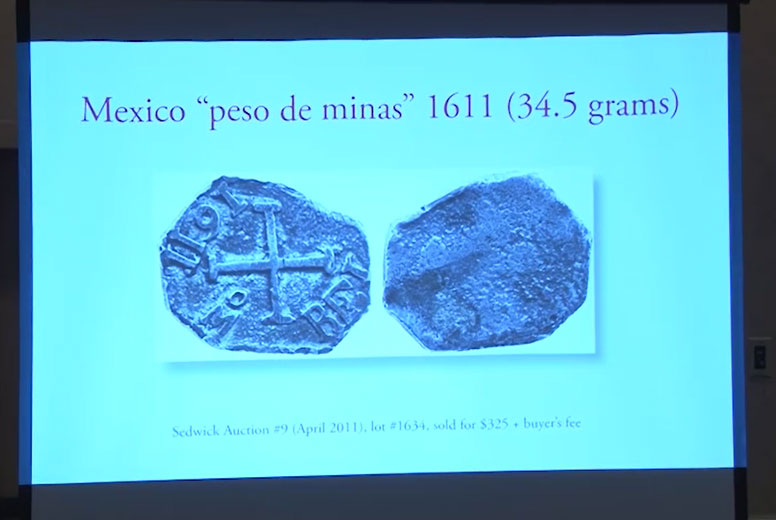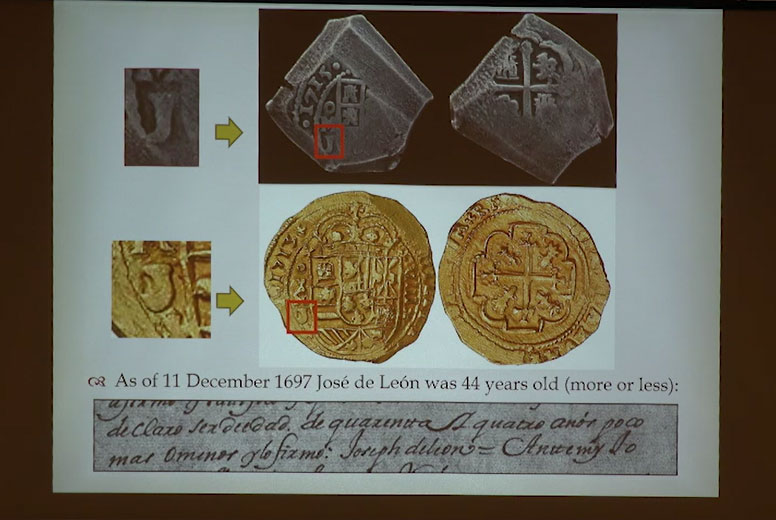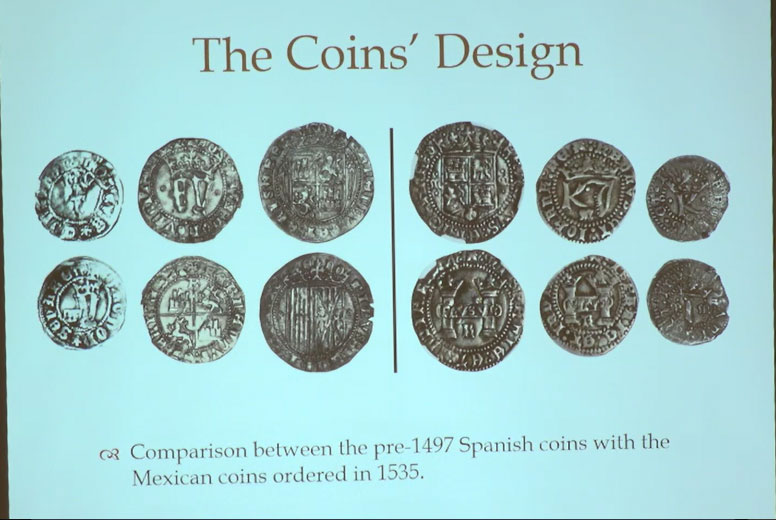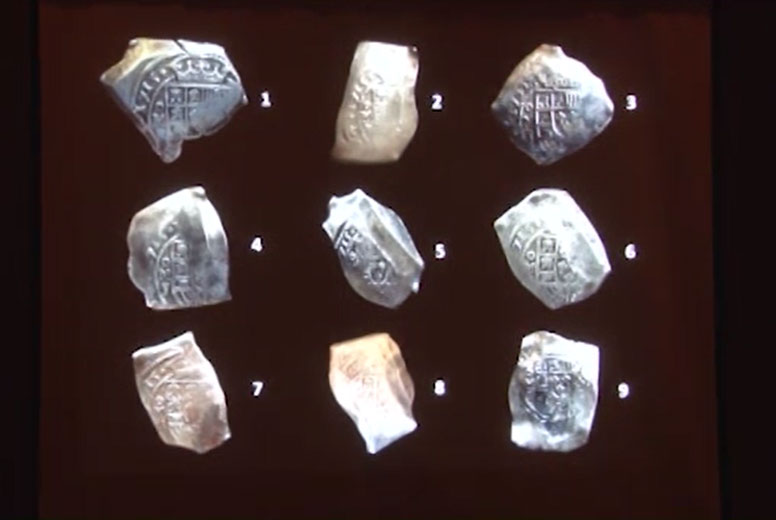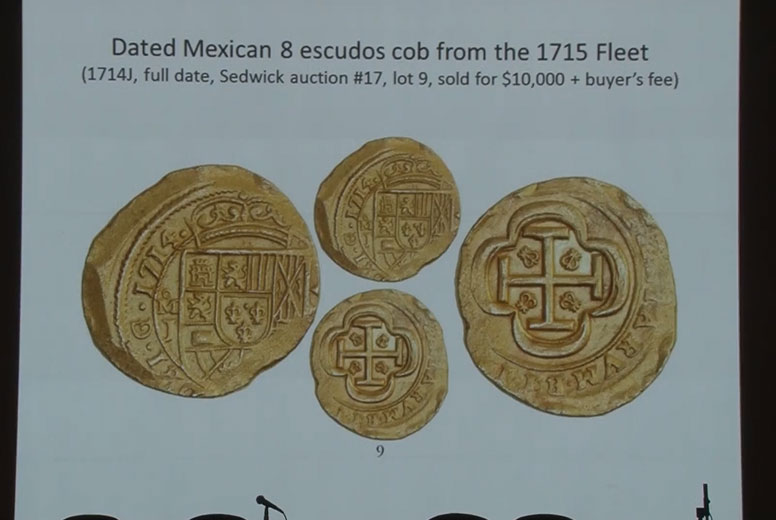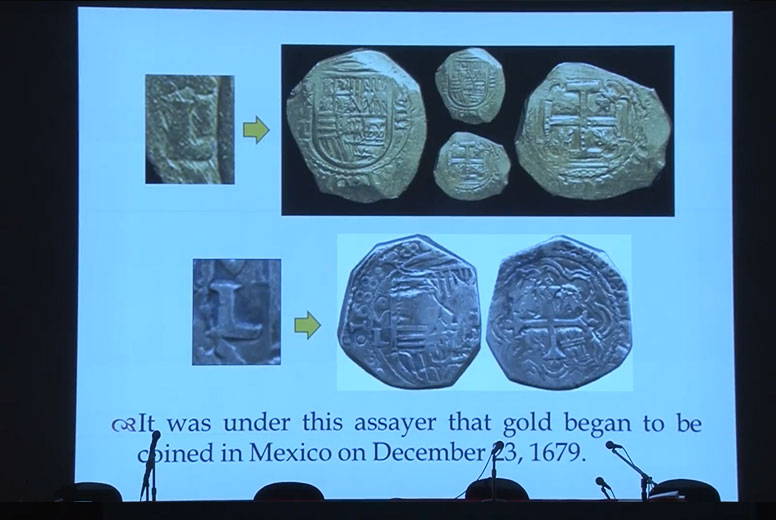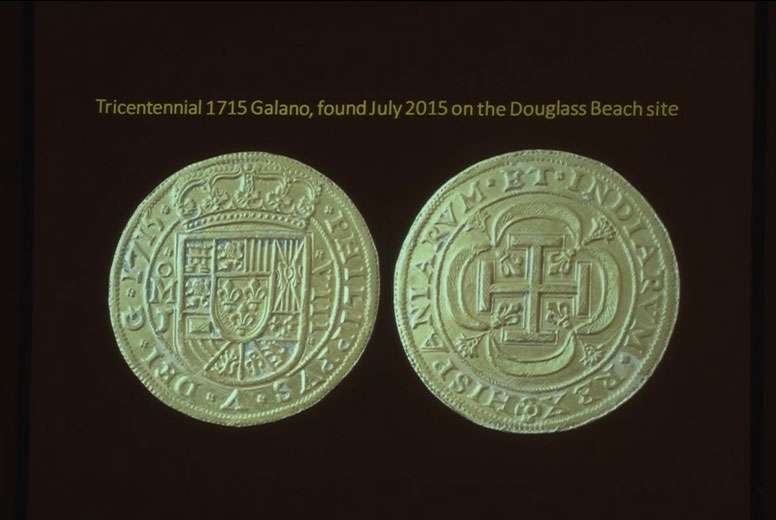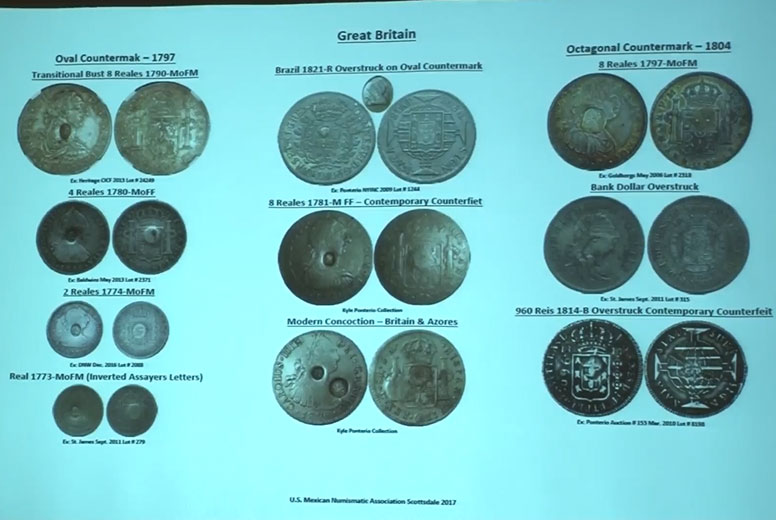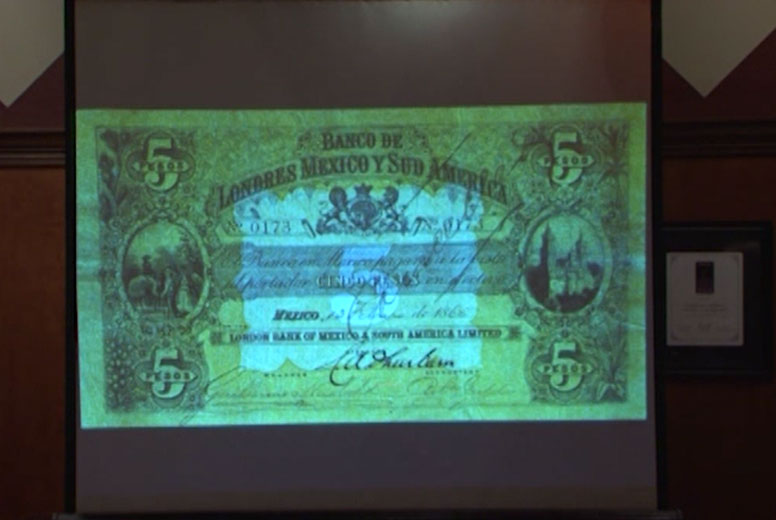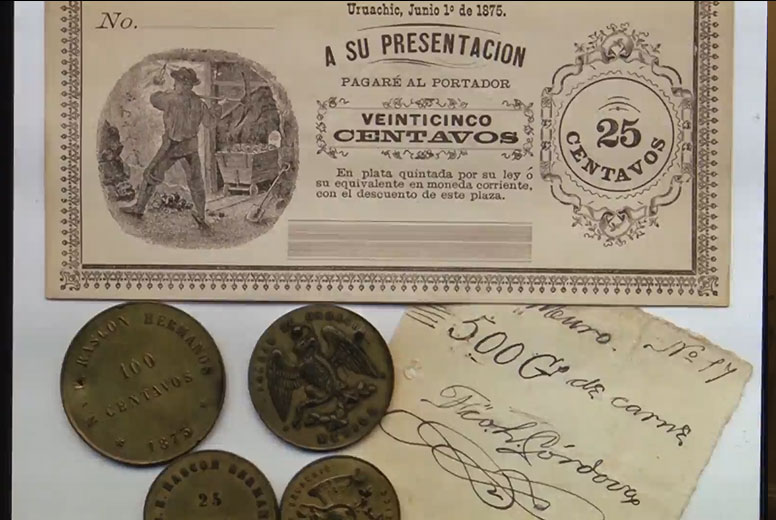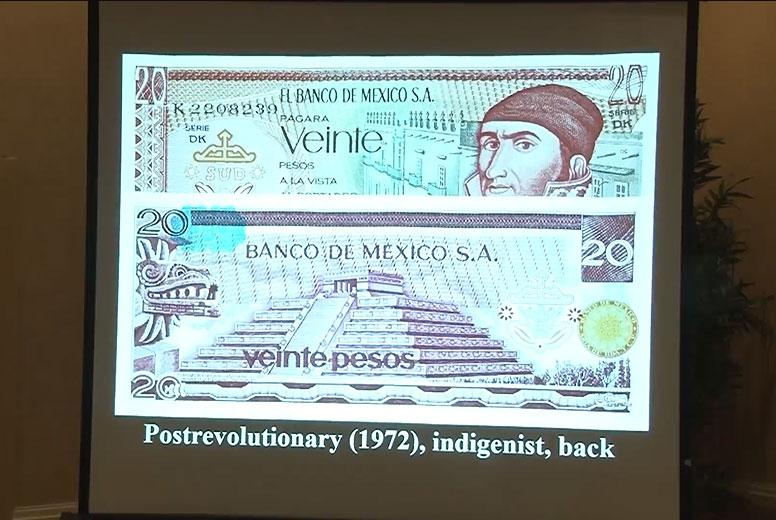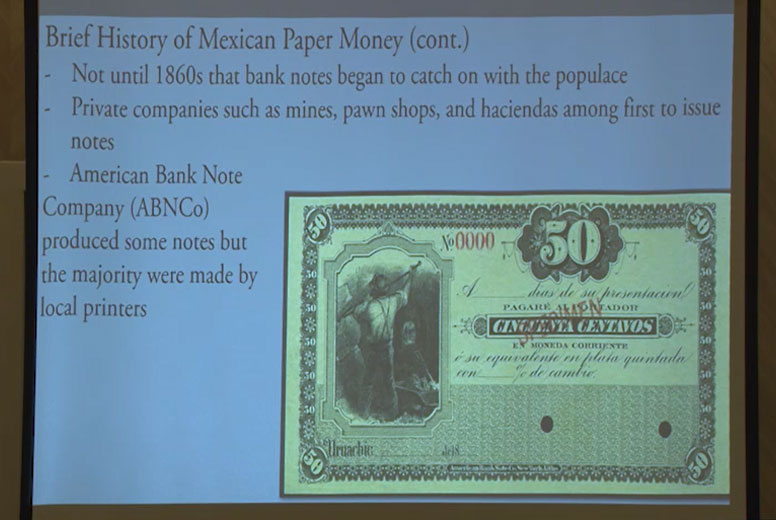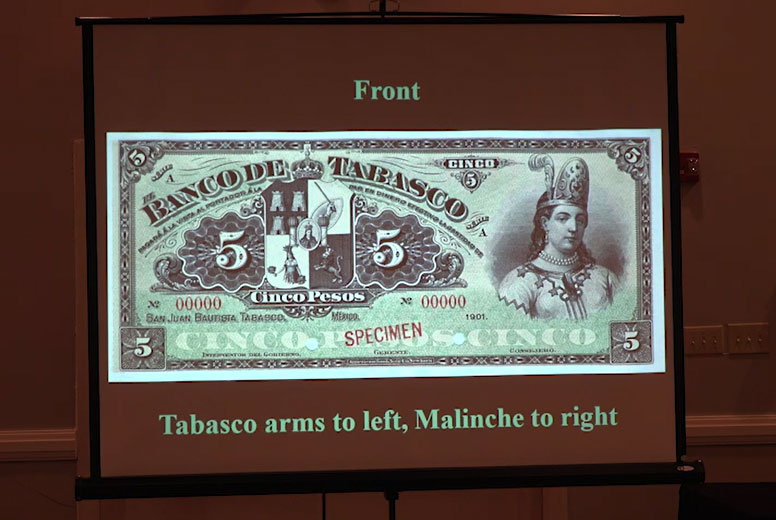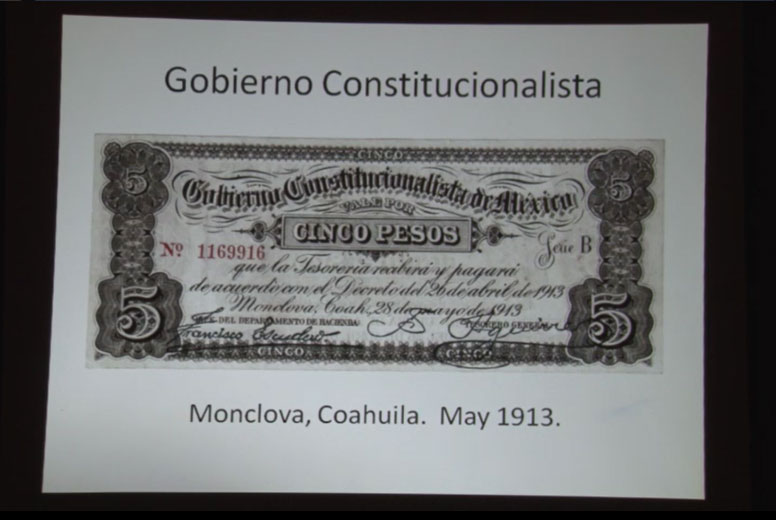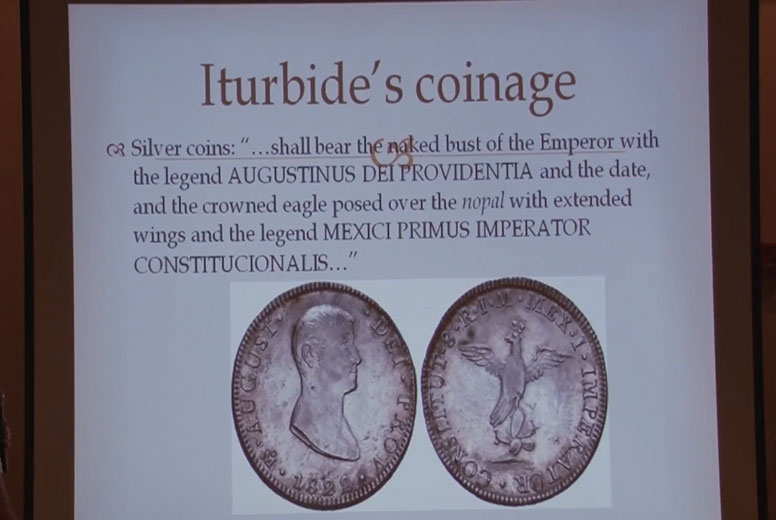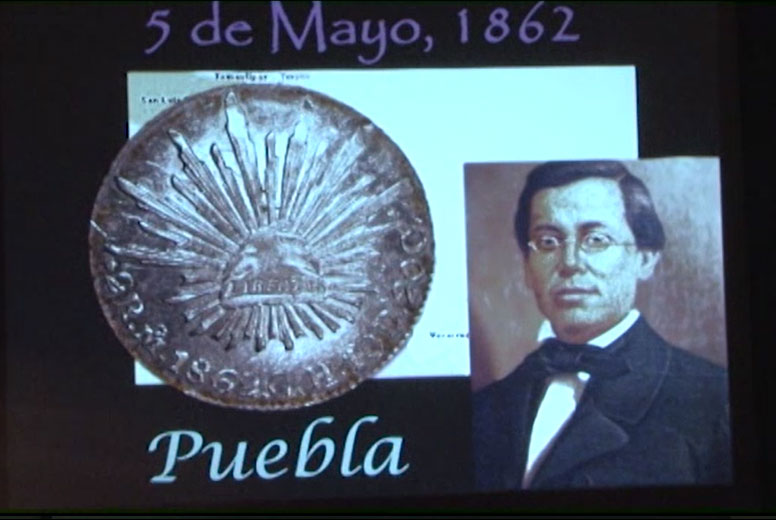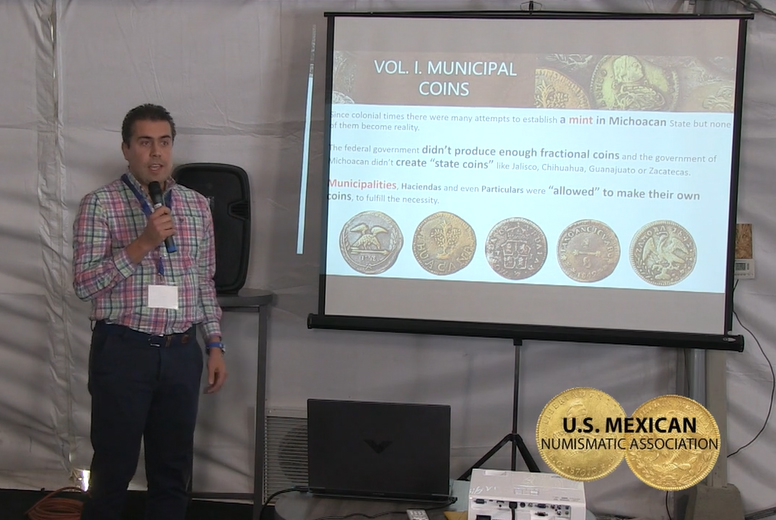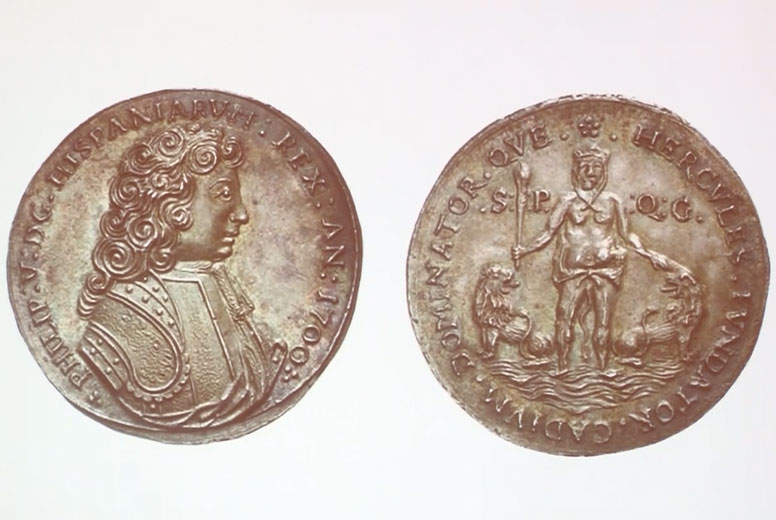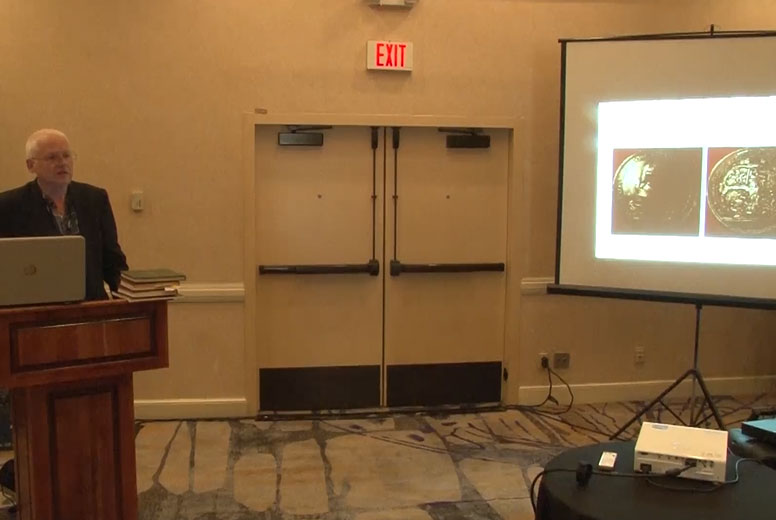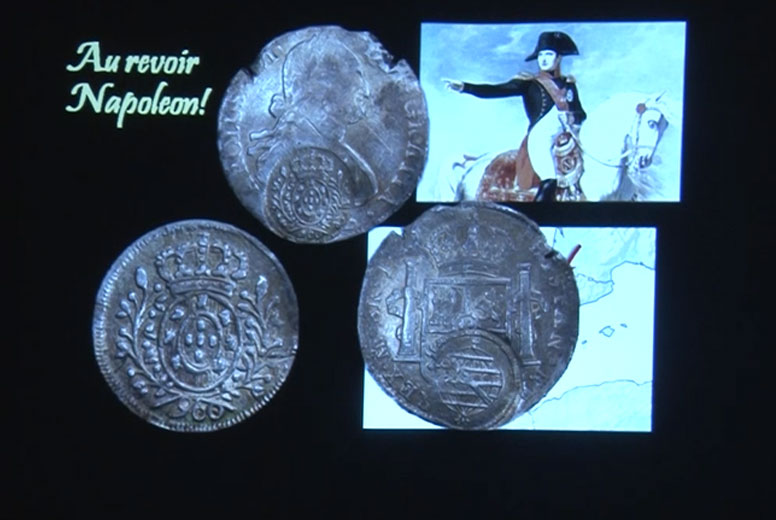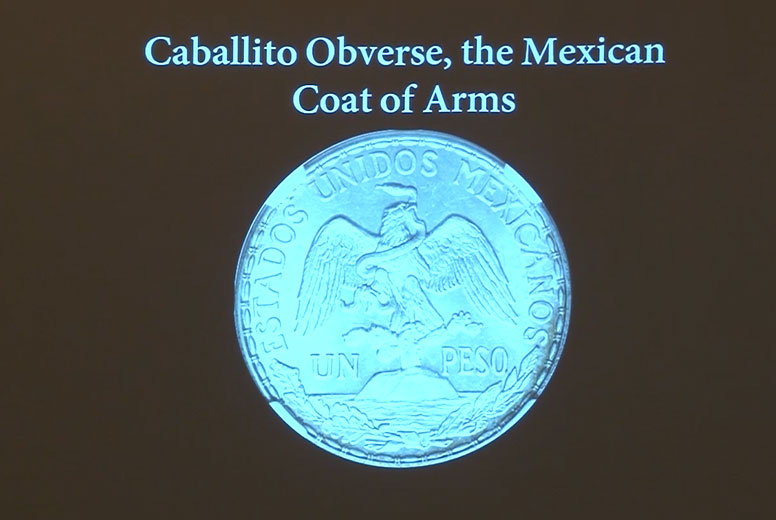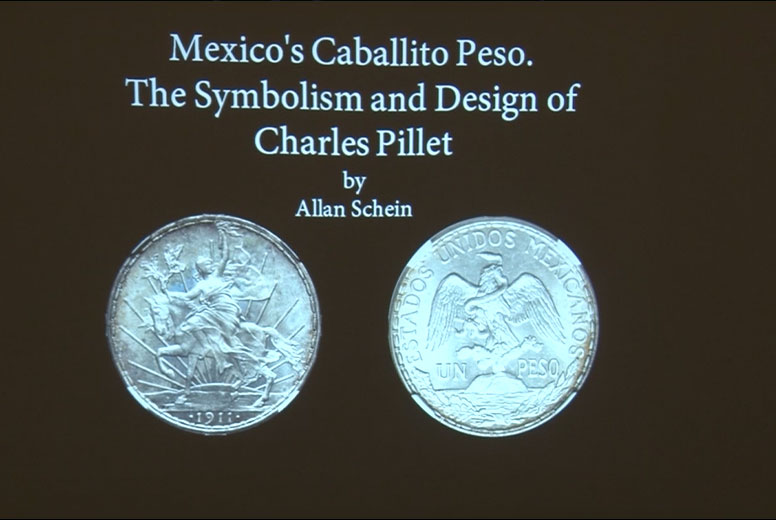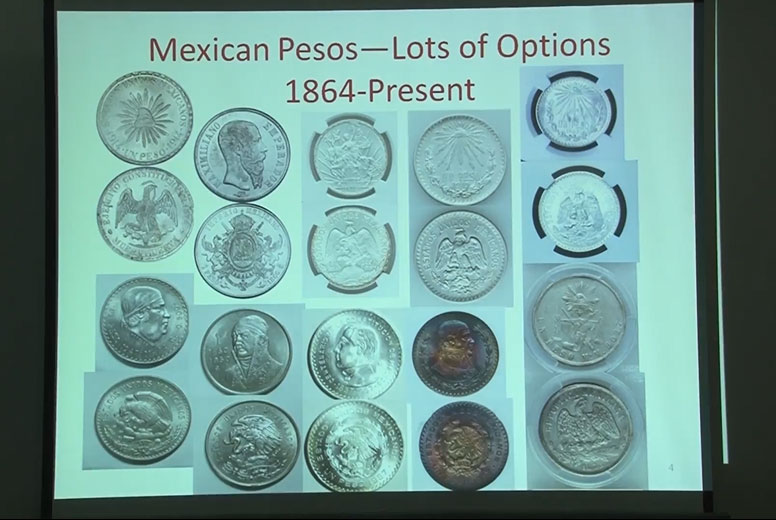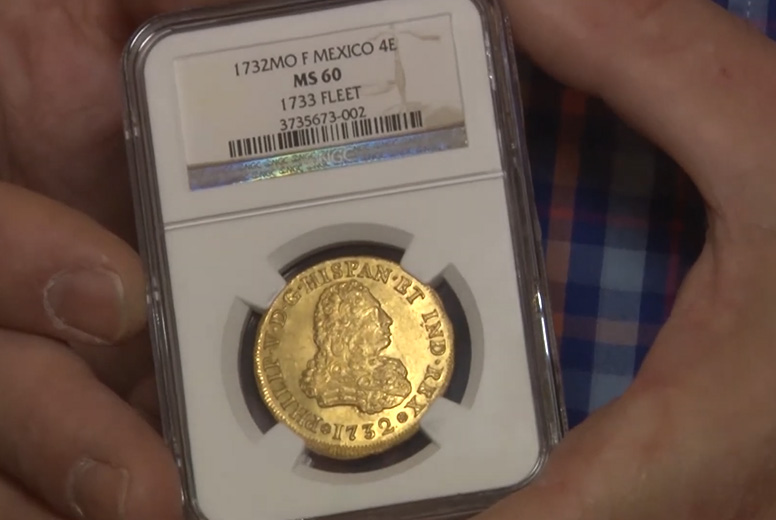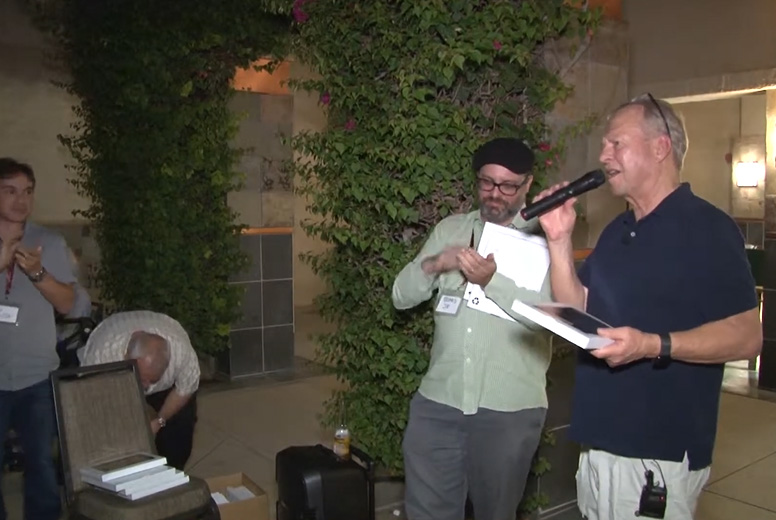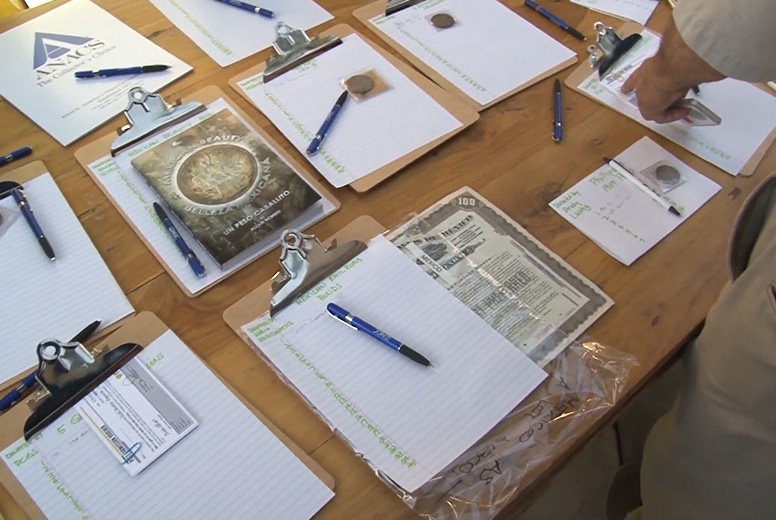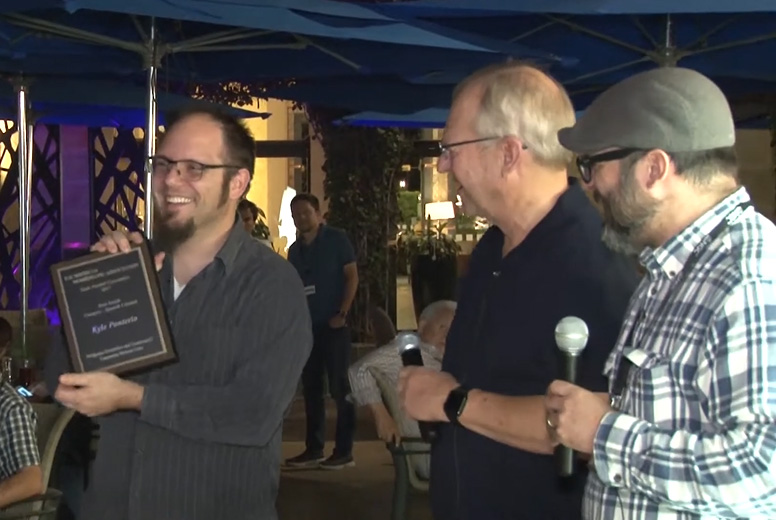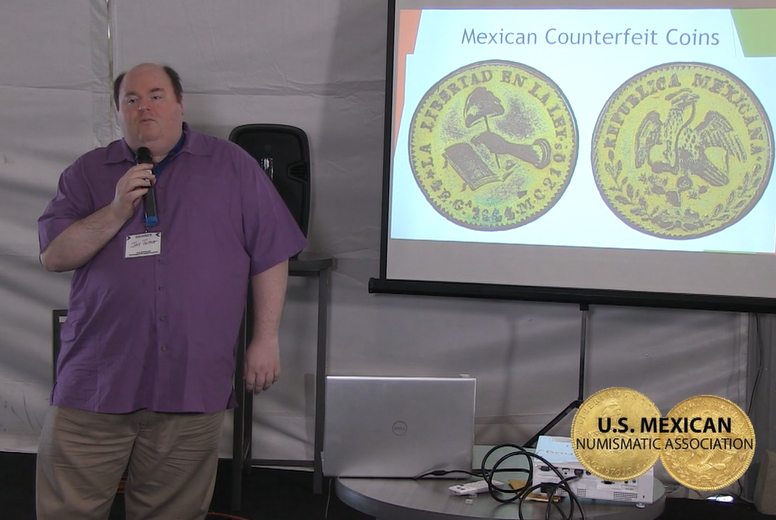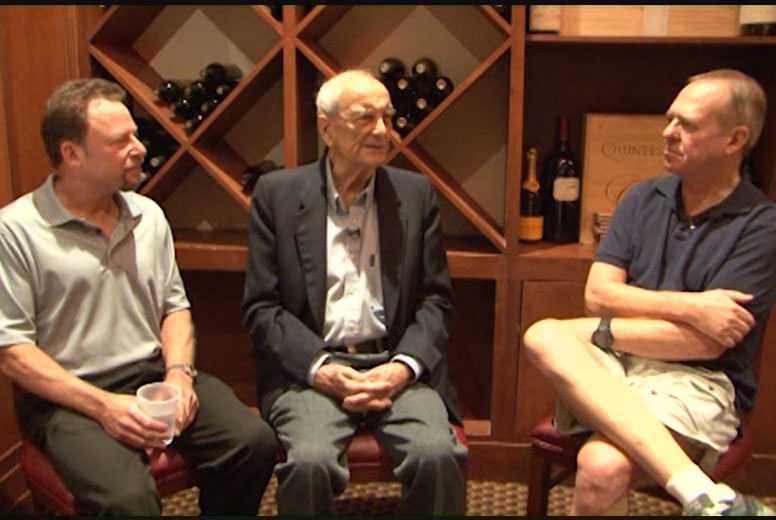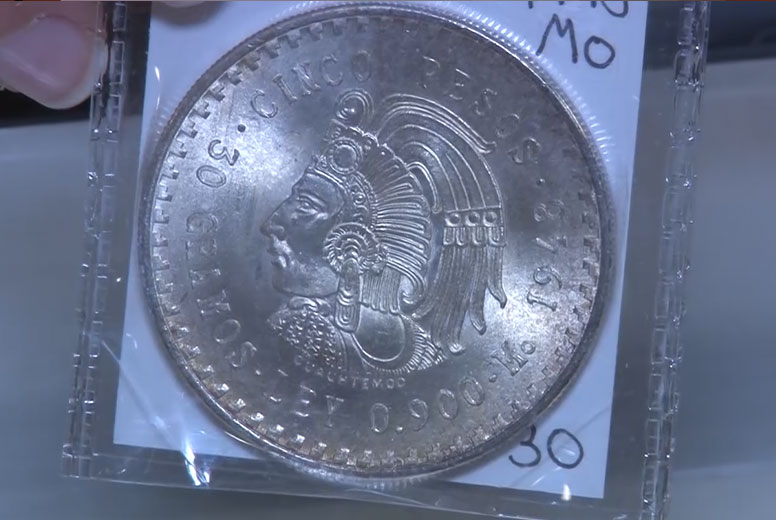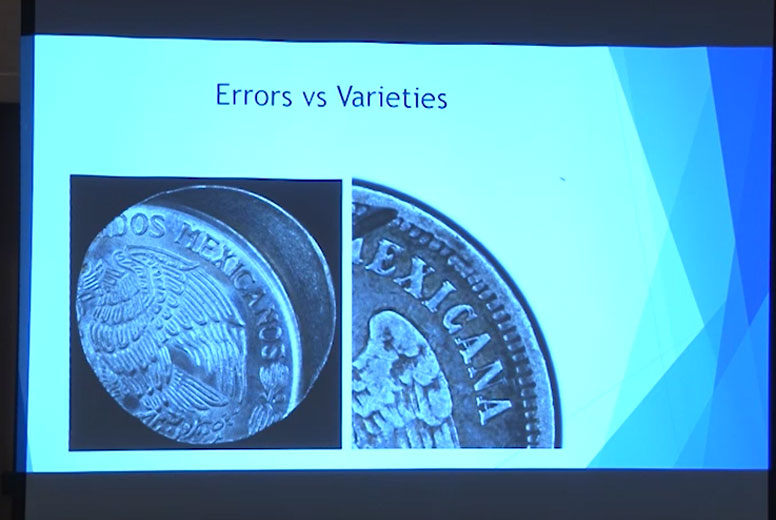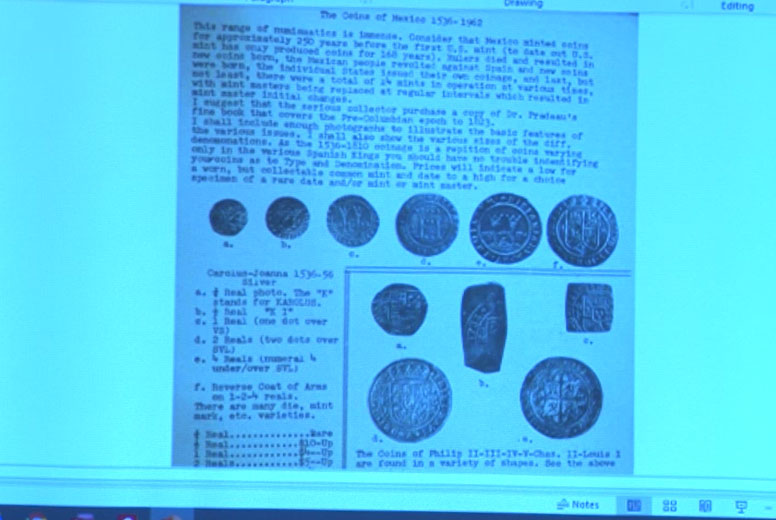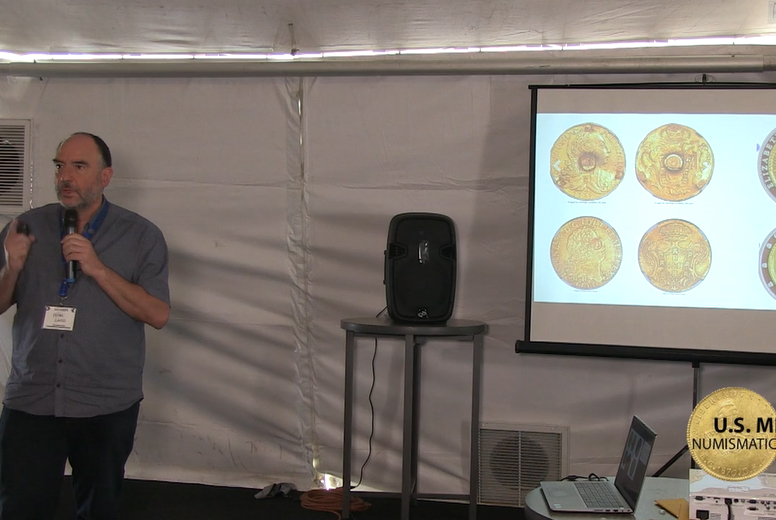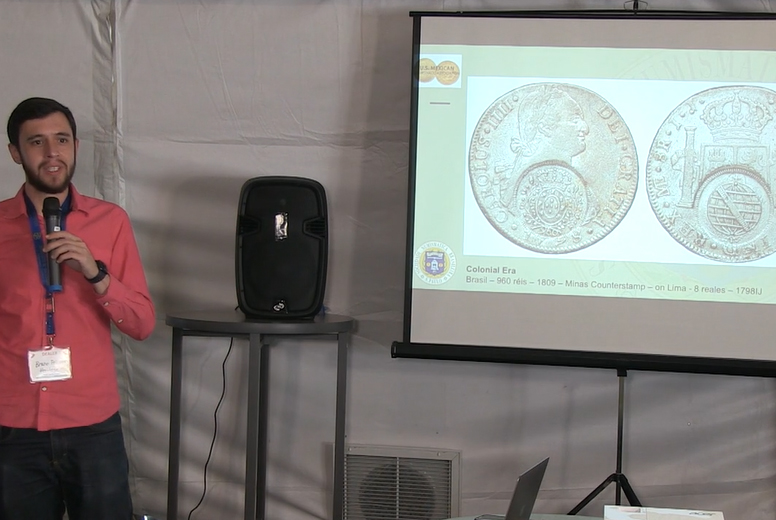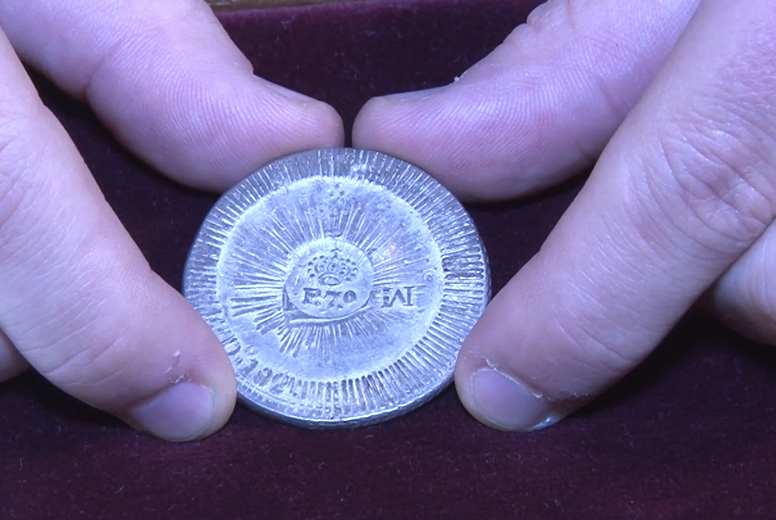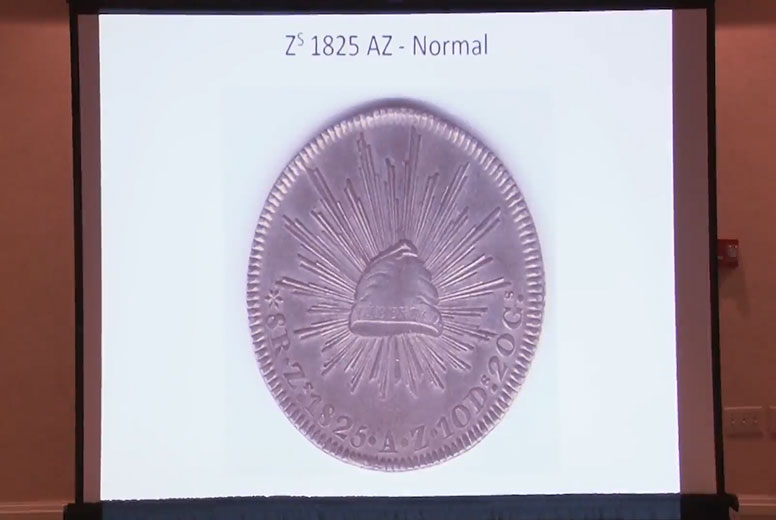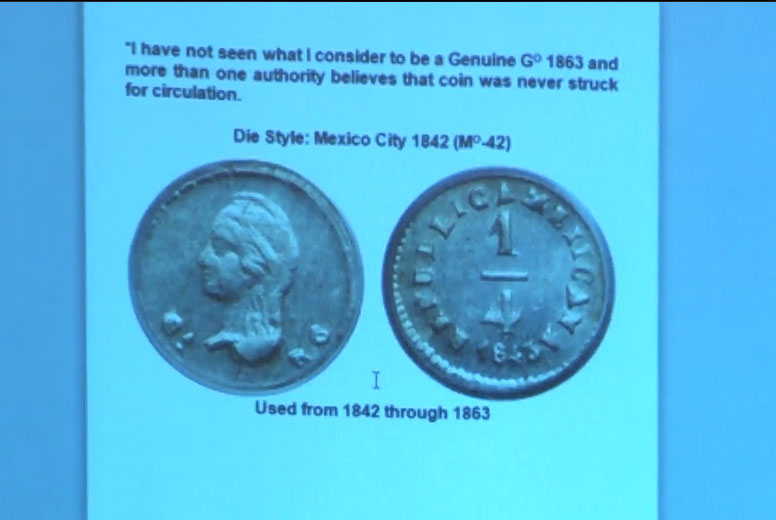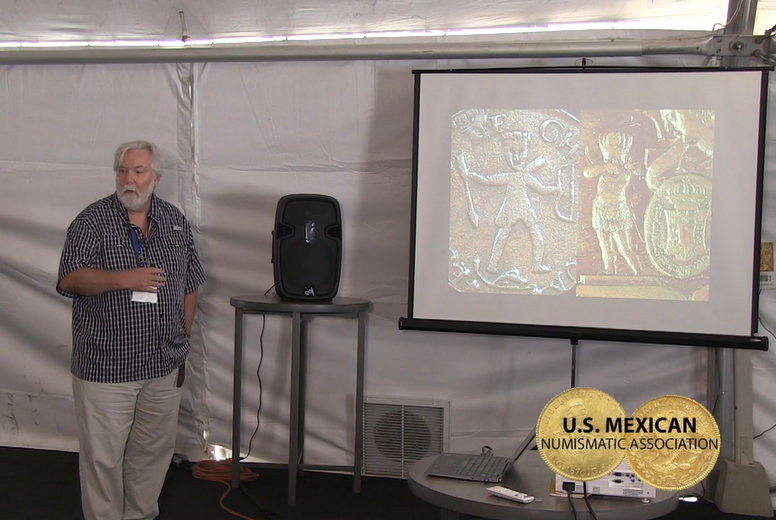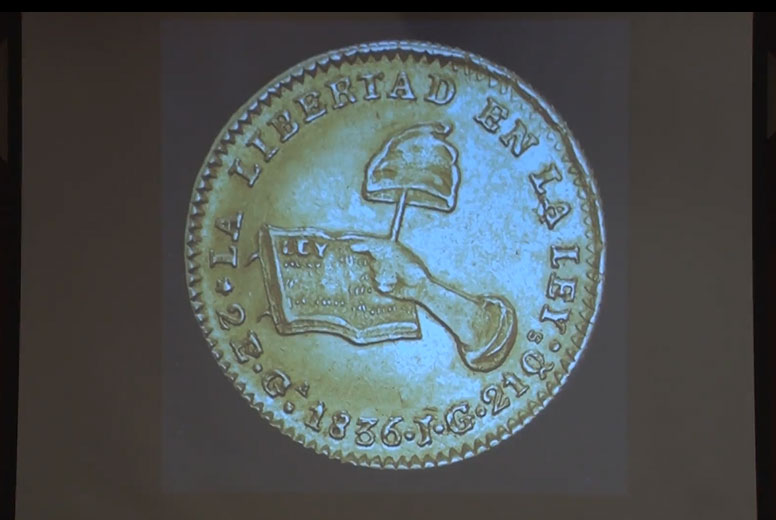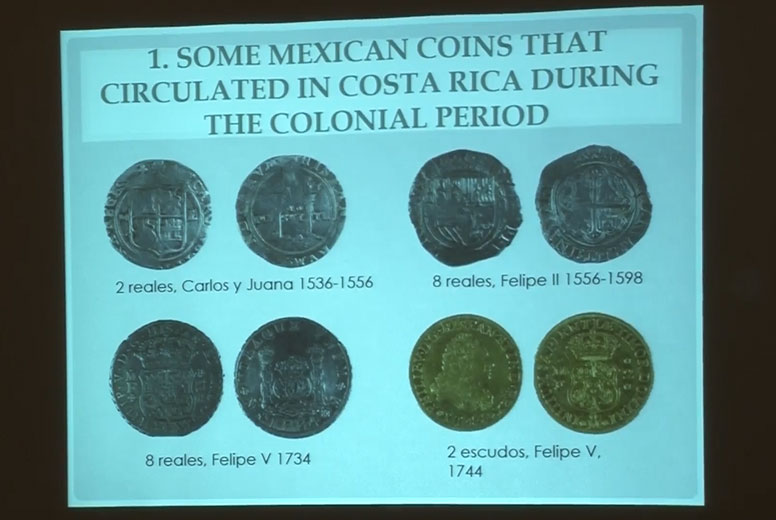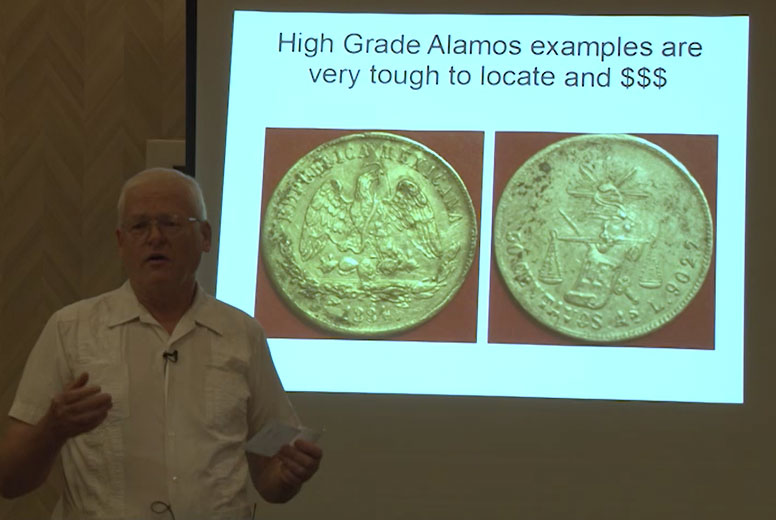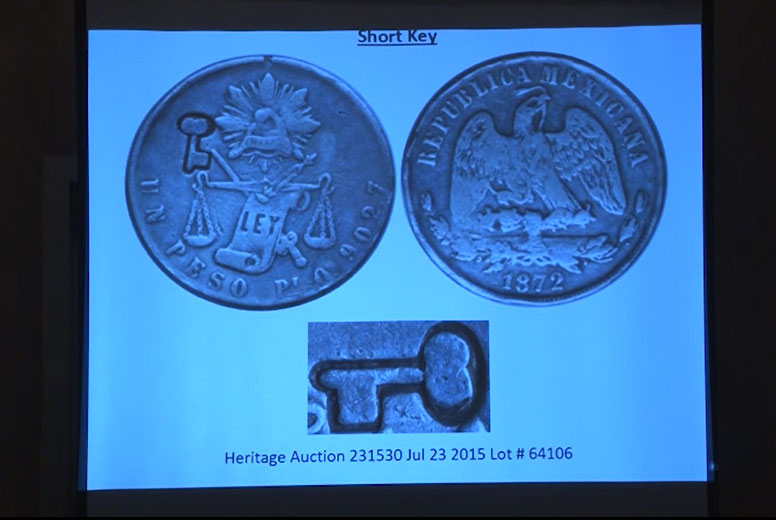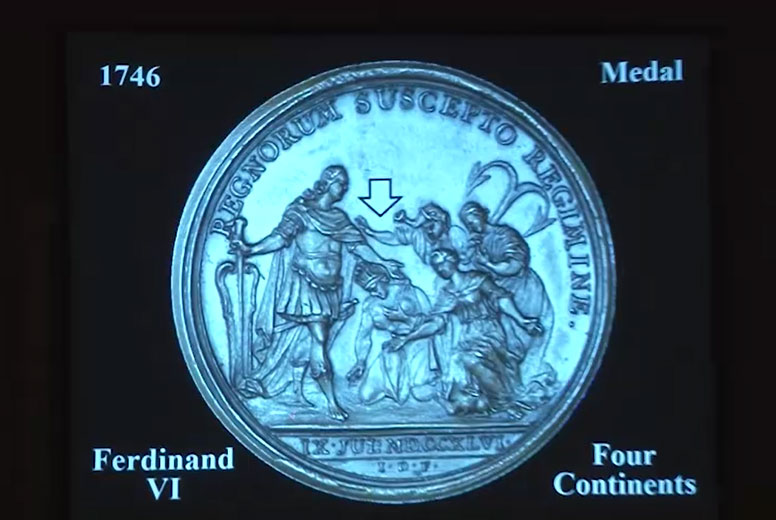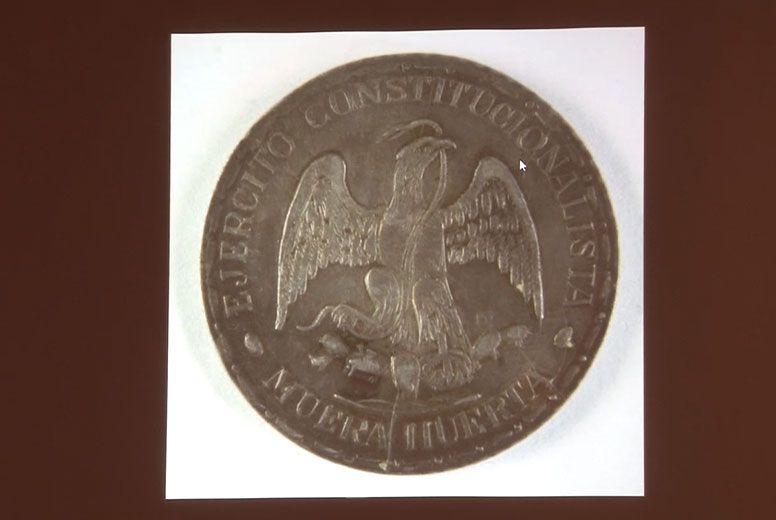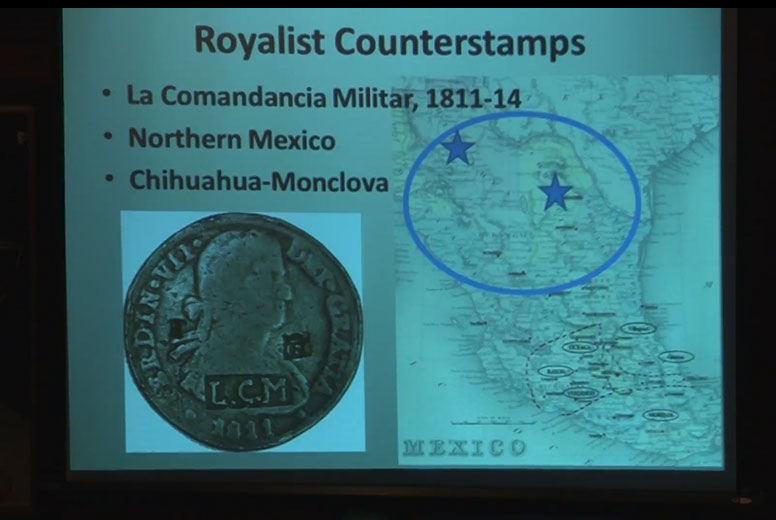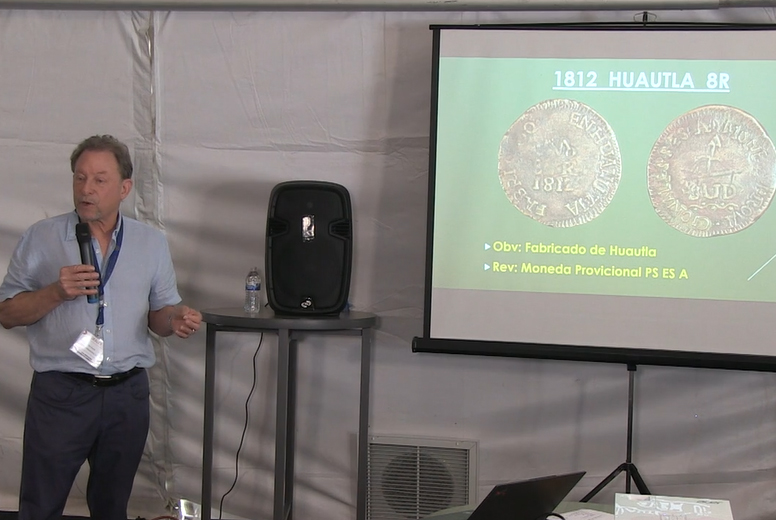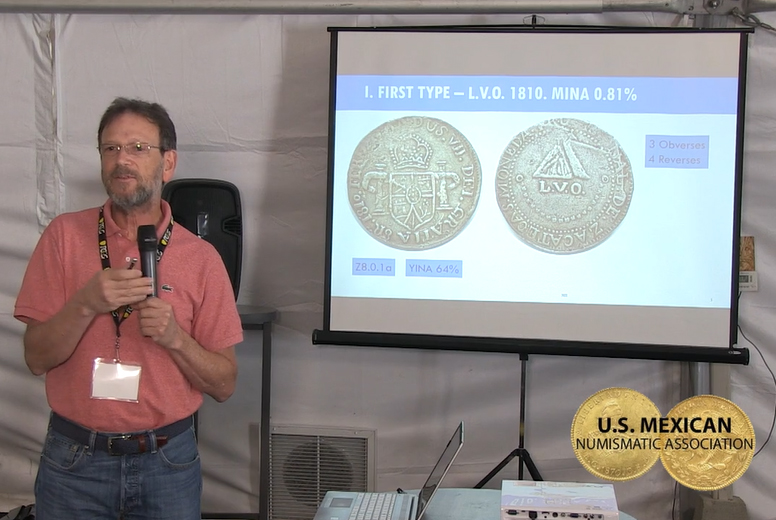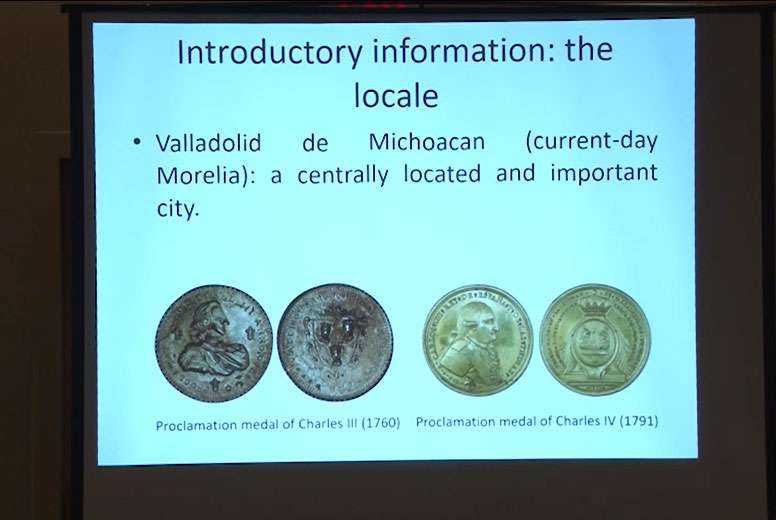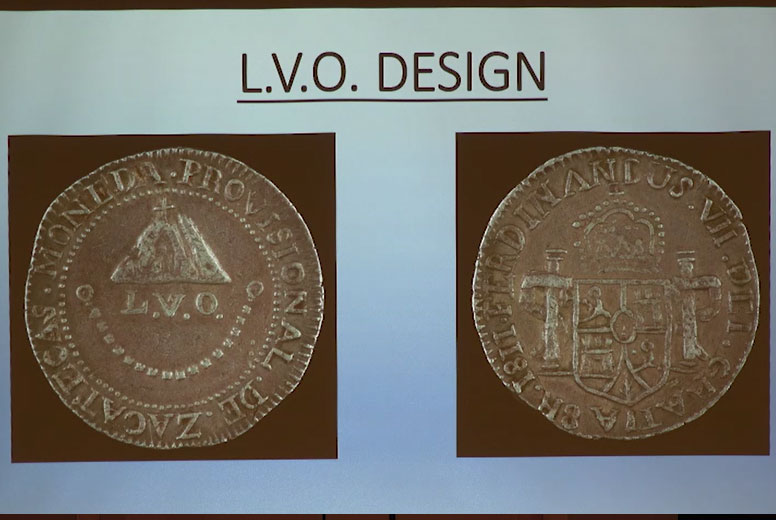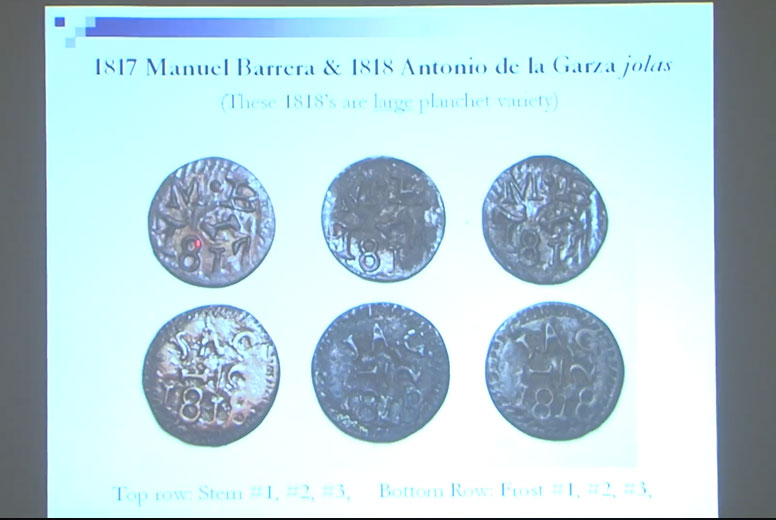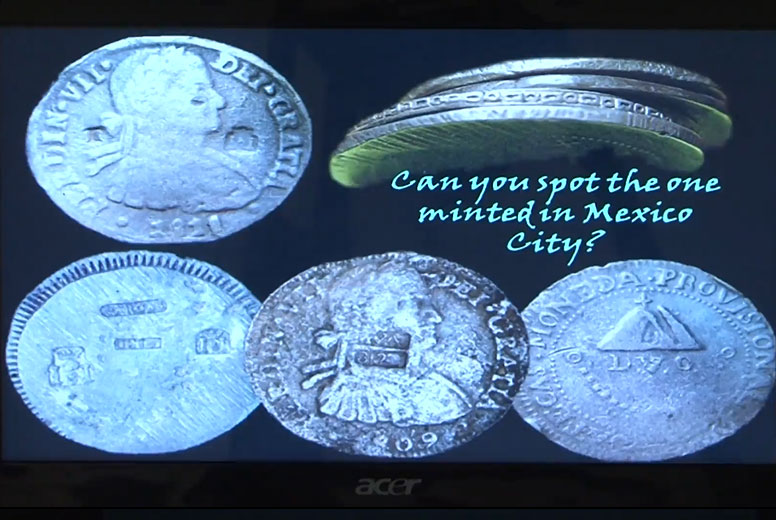Establishment of the Banking System in Mexico, 1864-1910
This presentation covers the way the Mexican Banking system was successfully established and how it was running until 1910, right before the Mexican Revolution.
Spanish Colonial Cob Coinage of Philip II & Philip III
Kent Ponterio offers what he describes as a “brief overview” of the “cob” coinage of Philip II and Philip III.
Pillar Fractional Coins of the Mexico City Mint
Brad Yonaka, author of A Variety Guide to the Fractional Pillar Coinage of Mexico City 1731-1771 discusses the four lower values in the Pillar series. His emphasis is on production and rarity, the different types of varieties, and die-matching.
Spanish Colonial Contemporary Counterfeits
The portrait style 8 reales produced in Spain’s new world colonies from 1772 to 1825 was one of the most well known and extensively circulated silver trade coins. The popularity and general acceptance of this particular coin made it the object of forgers who operated not merely in the countries of origin but in all of the places where it was accepted as currency. In his book, Counterfeit Portrait Eight Reales, Bob has identified four different classifications of counterfeit 8 reales, and illustrates and describes literally hundreds of different types of counterfeits.
Shipwrecks and Mexican Coins
Daniel Sedwick begins by stressing the importance of shipwrecks to Mexican numismatics in substantially increasing our knowledge and as a source for the choicest specimens, especially of the higher denominations that were mainly minted for export. Sedwick then runs through a chronological list of shipwrecks with Mexican coins, and shows how the sequence of Mexican types and assayers was mirrored in the shipwrecks, and how many previously unknown dates and types have been discovered. Sedwick also touches on the archaeological and governance issues.
Gold Cobs of Mexico
Philip Flemming’s talk focuses on the first gold cobs, the jeweled cross series of 1679-1699. Philip discusses the political reasons why Mexico took so long to begin minting gold coins and then guides us through the complicated story of the design changes in the five denominations.
Evolution of Symbolism on Mexican Coinage
Max Keech discusses the first coinage of the Suprema Junta and argues that the bird on Mexico’s national symbol was originally not an eagle but a cara-cara.
The Hidden Mint Scandal of Mexico, exposing a case of corruption and a great cover-up,
Jorges discusses a case of corruption and a subsequent cover-up that took place in the Mint of Mexico in the 1720s and 1730s Run time: 71.34
Cobs and the Maritime Silk Road
The Spanish “Piece of Eight”; the first universal currency used on a global scale for centuries, was recognized for its purity of metal, consistency of weight, availability in quantity and ease of identity. It was used the world over, from the Galleon trade to the Silk Road, a vast centuries-old network of overland and maritime trade routes connecting East and South-East Asia to the Middle East, West Africa, the Mediterranean and ultimately Europe. Kyle gives a detailed commentary on a varied group of Philip II & III cobs from Spanish and Spanish colonial mints discovered in Yemen. From ancient times till now the Arabian Peninsula is quite familiar with producing coinage either of local design or in imitation of current circulating specie and in the group that Kyle discusses are some such coins. Run time: 39:06
Collecting Mexican Republic Half Reales
Bill Sigl explains that Republic Half Reales are a very seductive series, drawing in collectors because of the large number of Dates, Assayers, and Mints (DAMs) that are available in AU or BU for reasonable prices. So many collectors initially fall in love with the series, but after the common DAMs are acquired, most start to lose interest and go on to other series. However, often overlooked by most collectors is the excitement of collecting the number of varieties in this series, both those that are catalogued, and those that have yet to be discovered. Run time: 1:12:21
Mexico Peso de Minas of 1611
Dan Sedwick discusses the enigmatic “peso de minas”. He lists all the mentions published since 1854 and concludes that there were probably some original pieces with designs on both sides but that Orozco and Berra’s Diccionario Universal in 1854 showed only one side and this led to one-sided castings produced for collectors. Run time: 27:18
Assayers of the Mint of Mexico During Reigns of King Philip V & Louis I
Jorge Proctor gives a detailed and comprehensive account of the mint assayers in the 1500s using actual records from the archives in Spain. This information sheds light on the coinage production during these two different Spanish kings.
Mexico's 16th Century Pillar Coin Series: The Documentary Evidence
More original research from Jorge Proctor from the Spanish Archives in Seville talking about Pillar coinage.
System for Grading Mexican Silver Cobbs Recovered from 1715 Fleet
Grading hand struck coins from Mexico requires a different system from grading the machine struck from later eras.
Numismatic Impact of the 1715 Spanish Treasure Fleet
Daniel has the most successful auction for the sale of treasure coins and artifacts. He talks about and shows examples of such treasure and it impact on the market. Running time: 40:47.
Mexican Coin Assayers of the 1715 Spanish Treasure Fleet and the Barefoot Carmelites
Jorge Procter presents his massive body of research about the coin assayers at the time of the Spaniards in the New World in the early 1700s. Running time: 46:38
Mexico City Eight Escudo Gold Coins of 1715
Phil Flemming tells the story of the 1715 8 escudo and the different types and varieties.
World Countermarks on Mexican Coinage
Early Mexican coins were one of the first worldwide currencies. Many countries counterstamped these coins to validate their usage, and Kyle outlines many of these counermarks.
Historical Images on Mexico's First Currency
Peter Dunham shows how to apply archaeological and anthropological methods to “read” a note and demonstrates how the design of the first banknotes of the Banco de Londres, México y Sud America incorporated British, French and Mexican “mestizo” themes. He shows how the designer had taken certain images from Casimoro Castro’s México y sus alrededores (1864), but, more interestingly, had not included other elements from the same lithographed frontis such as iconic indigenous figures or archaeological remains, or any nationalist image such as Hidalgo or the coat-of-arms. So the design carried ethnic and political messages relevant to the Maximilian regime. Peter then illustrates how quickly indigenous and nationalistic images then appeared on Porfirian banknotes when the political climate changed.
Paper Money of the Mexican Revolution
After a brief introduction to the background to the revolution Elmer takes us through the various issues made by Carranza and the other revolutionary leaders, by Huerta’s banks and the Federal forces besieged in Monterrey, Saltillo and Guaymas, and then through the various attempts to introduce a unified national currency.
One Peso Bank Note of the Banco Minero
Peter Dunham discusses the $1 note of the Banco Minero of Chihuahua, first issued in 1889, with the vignette of a generic native princess, but seated on a stone throne, with Aztec features. Peter has tracked down the origin of this image. It is a tepetlacelli, an Aztec sacred carved stone box (far smaller than a throne) that was then in the Louvre, Paris, France. Peter suggests that the vignette personifies Mexico and signals her rebirth with the restoration of Mexican government after the French intervention.
Mexico Personified Rise & Fall of a Native Avatar
Peter Dunham gives the fourth talk in a series covering the imagery on Mexican banknotes and in this presentation tells the story of the allegorical image used to depict Mexico and how it evolved. Run time: 1:06:07
Vignettes of the American Bank Note Company
Connor begins by giving a brief history of the ABNC and a general overview of the design process. He then details the various types of vignettes that the ABNC produced, either to specific order or to make up their own stock, and how they were shared across banks and issues. The ABNC was reorganised several times and its archives were sold in the early 1990s, releasing a plethora of proofs, specimens and remainders to the collecting public. Run time: 34:14
Face of La Malinche: Her Rehabilitation of a Tabascan Banknote
Peter Dunham shares his research on the girl used to personify the nation of Mexico on paper money.
Iturbide's Coinage of Mexico
Carlos Jara begins with a brief review of the major types of coins issued with Iturbide’s effigy. All of these were engraved by Torreblanca, who had little experience, and Carlos outlines a logical argument for the numerous different successive types for these issues which clearly represented improvements of the design.
The Coinage of Maximilian
Ricardo de León Tallavas gives a talk on the coinage of Maximilian, the French-imposed Emperor of Mexico. [NOTE: incorrectly entitled “Mexico in 1914: Numismatic Virtues and Vices”]
Michoacan Numismatic Encyclopedia: Volume #1 Municipal Coins
Ricardo Vargas Verduzco presents Volume 1 of his projected Numismatic Encyclopaedia of Michoacán, (Enciclopédia Numismática de Michoacán), dealing with Municipal coins (Moneda Municipal). Ricardo explains that these coins were issued because the federal government did not provide enough fractional coins (1/4 and 1/8 real) and the state government of Michoacán did not produce them so municipalities, haciendas and even private citizens were “allowed” to make their own, though as these were repeatedly permitted and then prohibited, coins would be struck, then melted or revalidated via counterstamps, and then struck again. This latest encyclopaedia has 240 coins, all municipal and mostly illustrated in full colour. Run time: 17.25
Mexican Proclamation Medals
Each time there was a new king in Spain a special medal was issued to commemorate the event. These medals can be quite rare and many are very beautiful.
Mexican Colonial Proclamation Medals
Bill Sigl has built up a database which gives him insight into rarity and pricing. The market is dominated by type collectors and speculators with very few people building a proclamation medals collection and consequently rare proclamation medals, that are not known to be rare, go for low prices, whilst known rarities command high prices. Bill distinguished six categories of medals, based on who made them and for what purpose. Four refer to swearing allegiance to a new king: while the two others are the commemoration of events, such as royal births or the restoration of Spanish rule in 1814.
Caballito Pesos of Mexico
Allan, author of Mexican Beauty/Belleza Mexicana Un Peso Caballito, describes the history of this much loved coin. designed by the Frenchman Charles Pillet. The significance of each design element is discussed.
Mexican Silver Peso Coins
Dr. Bartanowicz talks about this beautiful Mexican peso series from 1920-1945, which he believes is a tremendous opportunity! Running time: 23:32.
Mexican Counterfeit Coins
Jay Turner, Senior Grader at PCGS, states that there is a wide range of counterfeits in Mexican coinage and identifies five main types of counterfeits, illustrating his talk with slides that compared genuine and counterfeit coins. He noted that there is massive collecting interest in contemporary counterfeits, which can be distinguished by differences in weight, design, and XRF analysis, and warned against modern counterfeits from the Far East. Run time: 48.54
Numismatic Personality: Clyde Hubbard, November 3, 2012
Two principal players from the Mexican Coin Company interview longtime Mexican and Latin American coin collector Clyde Hubbard.
World Mint Errors and Varieties on Coins
Jay’s talk and PowerPoint presentation overviews the modern minting process and shows how through each process mint errors and varieties can be created. Run time: 50:52
Collecting Mexican Coins in the 1960’s and 1970’s
H.T. Nance reminisces on what he recalled as the golden period, with a steady flow of coins (often surreptitiously across the Mexico-US border), the appearance of influential books on the subject, and type set albums and checklists to guide the, particularly young, collector. He illustrates his talk with pages from books and prices lists of the time. Run time: 47:53
Mud and Gold: History and Numismatics of the Minas Gerais Mints and Foundry Houses
The Minas district of Brazil was responsible for half the global production of gold in the final decades of the 17th century, with Villa Rica (now Ouro Preto) the centre for minting and casting. Using archival material, maps, pictures and his expertise as a geologist and environmental consultant, Hilton shows how he had established that coining had been done, progressively, in three different buildings in that town. Run time: 68.29
Brazilian 960 Réis: The link between Portuguese and Spanish America (1809-1827)
Bruno Pellizzari, Director of the Numismatic Museum and Vice-president of the Brazilian Numismatic Society, gives an overview of the Brazilian 960 réis, and the link that it demonstrated between Portuguese and Spanish America. Run time: 62.59
Early Mexican Republic 8 Reales Die Varieties
Mexican eight reales offer collectors a great series to collect with many rare dates and a plethora of overdates and varieties. Mike Crowder provides specific examples of Facing Eagle die varieties that were created in four different ways: (1) By a mid-year die style change, (2) from the use of improper die punches, (3) from die sinker’s error and (4) due to an early mint struggling with die standardization.
Republica Mexicana Silver Minor Coinage Die Styles
Dave Busse begins by defining a type and then a style, the latter being the differences within a type where the basic elements remain the same, and then takes his audience through the various denominations from the ¼ real (cuartilla) to the 1 real, illustrating the different styles used by the various mints and outlining the known range of dates.
Native Identity and Independence on the Chihuahua Coppers of the First Republic
Peter investigates the ethnic and political significance of the native figure on the copper fractionals of Chihuahua from the First Republic (1833-56). He concludes that it is derived from the allegory of America of the four continents and races. The Chihuahuan figure is also related to the indigenous depictions in caste paintings and, in particular, looks a lot like the Chichimec of Parral, Chihuahua and indeed, is reminiscent of Teporaca, the great Rarámuri warrior still celebrated even today in Chihuahua. It is the masculine version of native Liberty (“Madre Mexica”) in the coppers of San Luis Potosí and is the Mexican version of the similar figures that adorn the coins of other recently liberated countries, like the Excelsior copper of New York. As a bonus Peter give a talk on the renowned photographer, William Henry Jackson (1843-1942) Run time: 85.24
Mexican Republic 2 Escudo Gold Coins
This series consists of many rarities and varieties.
Mexican Coins in Costa Rican Numismatics
Manuel Chacón, the curator of the Bank of Costa Rica’s museum talks about Mexican coins that were used in Costa Rica, due to the trade through Panama and the lack of coins in Costa Rica. He illustrates the various counterstamps that were applied to such coins during the first years of independence.
Collecting Mexican Republic 50 Centavos
Bill considers the validity of what he calls ‘urban legends’, (1) that the coins were common and not worth collecting in low grade, (2) that contemporary counterfeits are easy to spot, and (3) that there is a very low risk of modern counterfeits. Bill has concluded that the 50c coins in AU and BU are the rarest of all decimal denominations and so low grade 50 centavos are worth collecting. Contemporary counterfeits exist in small numbers and most were identified long ago while it is basically not worthwhile counterfeiting these coins. The 50c is still an unpopular series, with price increases tending to follow the price of the silver content, but they are nevertheless worthy of collecting. Run time: 59:10
“Key” Countermarks on Coins from Cuba’s First War of Independence
The vast majority of these key countermarks tend to show up in Mexico, on Mexican coins of 25c, 50c and one pesos (2, 4 and 8 reales) but they are occasionally found on US quarter and half dollars, with none dated beyond 1877. Kyle’s tentative conclusions are: 1. This countermark has a Cuban rather than a Mexican origin. 2. The countermark is coin-related though the only reference he has found so far to the financial situation at the time does not refer to a key. 3. So these could have been used to pay insurgent troops or for transactions in the insurgent-held areas. Run time: 50:14
Native Figures and National Identity of Early Coins of Mexico, Colombia, Costa Rica and the United States
Peter Dunham shows how the use of a native figure on banknotes to identify Mexico or Mexican liberty was part of a larger pattern for other countries. This phenomenon occurred in these countries not necessarily at the same time but at the same stage, right in the wake of independence. Mexico synthesized its own Native Liberty icon in the years surrounding its war for independence (1810-1821). An Aztec woman, she generally wears a feathered headdress and embroidered huipil gown, bears indigenous weapons and is accompanied by a cornucopia. On colonial art and medals, she embodied Mexican dependency and is often juxtaposed with Minerva representing Spain: after independence she was rebranded as Liberty to personify Mexican autonomy. Peter goes on to demonstrate that the same process had applied in other Latin American counties such as Colombia and Costa Rica and had occurred at an even earlier date in the United States. Run time: 1:05:01
Muera Huerta Peso of Mexico
Angel Smith tells the story of the "death peso" issued during the Mexican Revolution. In addition, he describes the most recent fakes aimed at collectors
Counterstamps on Coins of the Mexican War for Independence
Max Keech draws a distinction between a “mint stamp” (which was the final step in the production of a provisional/necessity issue when a stamp was applied to a cast coin) and a “counterstamp” (which was applied at a later date to validate a provisional/necessity issue). This distinction helps us to understand the who, where and when of a particular issue, and also to avoid counterfeits. Max then gives a tour of the Royalist mint stamps (Chihuahua, Oaxaca and Monclova) and Royalist counterstamps (La Comandancia Militar, Las Cajas de Vera Cruz, Armijo and Valladolid), outlining the various dates, host coins and suggesting reasons for counterstamping. With the Insurgents Max distinguished the different areas of revolt, and assigns various validation stamps to these different leaders, based on format and host coin.
Coinage of Morelos, 1811-14
Max outlines the six categories of Morelos’ coinage (Standard SUDs, 1812 Huautla SUDs, (1813) America Morelos half real, 1813 *T*C* Suds, Morelos’ counterstamps and 1814 Oaxaca style SUDs) and places each issue in its historical context. Run time: 61.14
War of Independence: 4 Reales Provisional Mints and Zacatecas 8 Reales
The Zacatecas mint was approved in October 1810 and started producing in November of that year. It was the most prolific mint and Juan showed how the design in both obverses and reverses, and the amount of silver, changed over time. Finally Juan discusses the far less common 4 Reales coins, produced from 1811 until 1817, by four different mints. Throughout his talk Juan draws on his knowledge of the scarcity of types, based on a study of over thirty years of sales records Run time: 48.50
Provisional Valladolid de Michoacan Coinage and the War of Independence
Carlos offers insight into the production and circulation of the Provisional Royalist silver coinage issued in Valladolid de Michoacán during the War of Independence. Run time: 36:15
First Insurgent Issue of the LVO Coin Series of Zacatecas 1810/1811
Max talks about the first coins of the Mexican War of Independence and the controversary surrounding their production
New Spain Texas Jolas of 1817: Origin of the Lone Star Symbol
This is the story of how the 1817 jolas were discovered, the varieties which surfaced, and the exhaustingly complex process, which was used by Bevill and his colleagues to authenticate them. It is nothing less than the verification of the first widespread use of the lone star symbol for Texas.
Mexican Emergency Mints of Chihuahua, Zacatecas, Durango, Guadalajara and Guanajuato. 1810-1823
During the struggle for Independence in Mexico, these five mints have amazing tales that were expressed in their coinage. A mystery might be finally put to rest as one coin could be proof that a long time numismatic suspicion might be correct.

